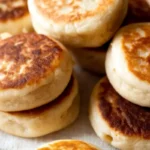Table of Contents
Crystallized ginger has been used for centuries in both cooking and natural remedies. This sweet and spicy treat is made by simmering fresh ginger in a sugar syrup, then coating it with sugar for a chewy, flavorful bite.
In this guide, you’ll learn how to make homemade crystallized ginger, the best ways to store it, and creative ways to enjoy it. Whether you’re adding it to baked goods, tea, or simply snacking, this step-by-step recipe will help you achieve the perfect texture and taste.
What is Crystallized Ginger?
Crystallized ginger is a delicious blend of sweetness and spice, made by simmering fresh ginger in syrup before coating it in sugar. With its chewy texture and warm, bold flavor, it’s a great addition to baked goods, teas, or enjoyed on its own as a snack.
Definition and Origin
Ginger has been prized for centuries in both cooking and natural remedies. In many Asian cultures, it was traditionally preserved in sugar to extend its shelf life and enhance its taste. Over time, this method spread globally, making it a popular ingredient in many recipes today.
Crystallized Ginger vs. Candied Ginger
While both forms of preserved ginger share similarities, they differ in texture, preparation, and culinary uses. Understanding these distinctions will help you choose the best option for your needs.
What is Crystallized Ginger?
This variety is made by boiling fresh ginger in a sugar syrup, then drying and coating it in sugar. The drying process removes excess moisture, resulting in a chewy, slightly crunchy texture. The sugar coating acts as a natural preservative, allowing it to be stored for months. It’s commonly used in baking, tea blends, and as a zesty snack.
What is Candied Ginger?
Unlike the dried version, candied ginger is left in syrup, making it soft, sticky, and extra sweet. Its syrupy consistency makes it a great addition to desserts, confections, and cake toppings, where its bold flavor enhances sweetness.
Both offer a sweet and spicy kick, but crystallized ginger is easier to store and handle due to its dry, sugar-coated surface. Whether you prefer a chewy texture or a syrupy consistency, each has a unique place in the kitchen.
Essential Ingredients for Making Crystallized Ginger
Making homemade crystallized ginger requires just a few simple ingredients. Here’s what you’ll need:
Essential Ingredients:
- Fresh Ginger Root – Choose firm, smooth ginger for the best flavor and texture.
- Granulated Sugar – Used to sweeten and coat the ginger.
- Water – Essential for boiling and making the sugar syrup.
Optional Ingredients for Flavor Variations:
- Honey – For a natural sweetener alternative.
- Lemon Juice – Adds a subtle citrusy brightness.
- Cinnamon or Cloves – Enhances the spice level for a richer taste.
Kitchen Tools for the Perfect Texture
To achieve the best texture when making crystallized ginger, you’ll need the right tools:
- Sharp Knife or Vegetable Peeler – For peeling the ginger skin.
- Cutting Board – To slice the ginger into even pieces.
- Medium Saucepan – Used to boil and simmer the ginger.
- Slotted Spoon – Helps remove the ginger from the syrup easily.
- Baking Sheet or Wire Rack – For drying the ginger after cooking.
- Parchment Paper – Prevents sticking when drying.
- Airtight Container – For storing crystallized ginger and keeping it fresh.
Step-by-Step Crystallized Ginger Recipe
Now that you have all the necessary ingredients and tools, follow these six simple steps to make delicious homemade crystallized ginger.
Step 1: Prepare the Ginger
- Peel the ginger using a spoon, vegetable peeler, or knife.
- Slice it into thin, even pieces (about ⅛ to ¼ inch thick) for uniform cooking.
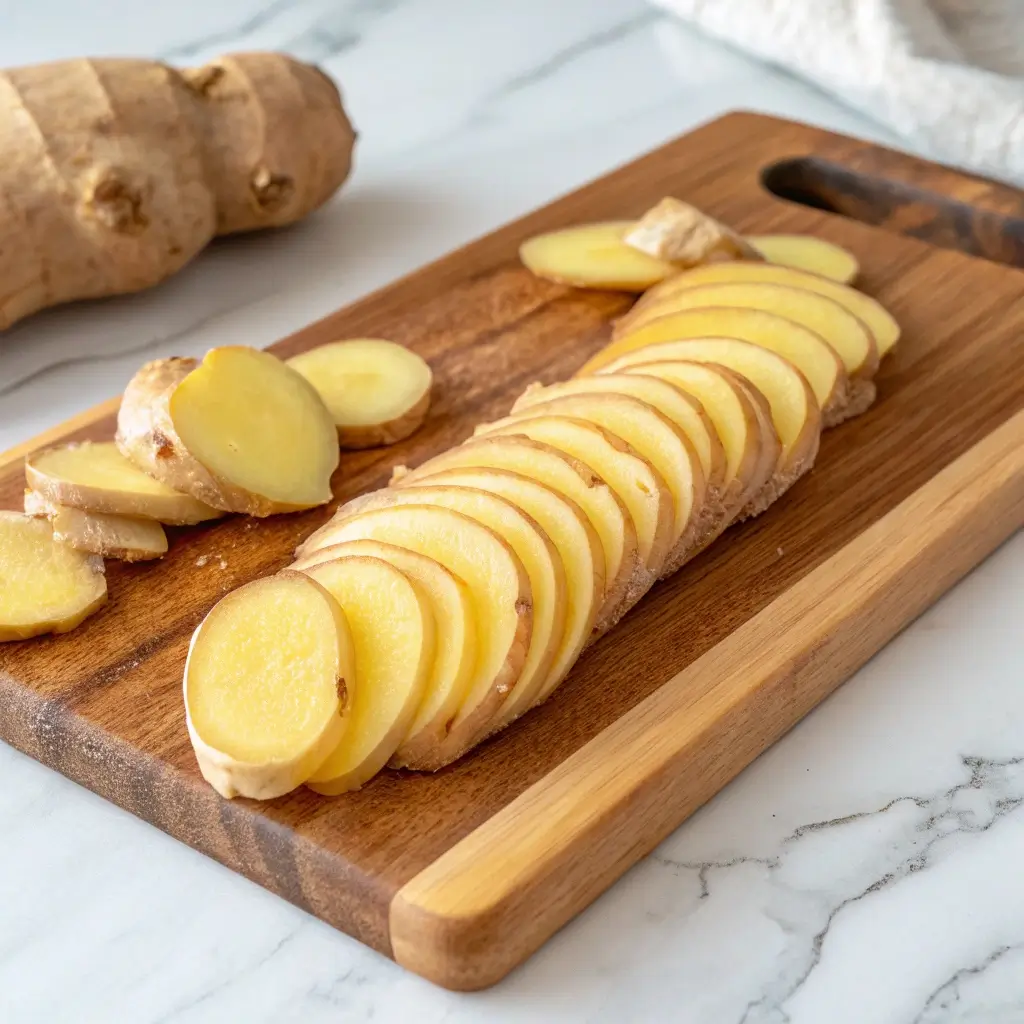
Step 2: Boil the Ginger
- Place the sliced ginger in a saucepan and cover it with water.
- Bring it to a boil and simmer for 30–40 minutes until the ginger becomes tender.
- Drain the ginger, but reserve ½ cup of the cooking water for the next step.

Step 3: Make the Sugar Syrup
- In the same saucepan, combine 1 cup of sugar with the ½ cup of reserved cooking water.
- Stir over medium heat until the sugar dissolves and the mixture starts to bubble.
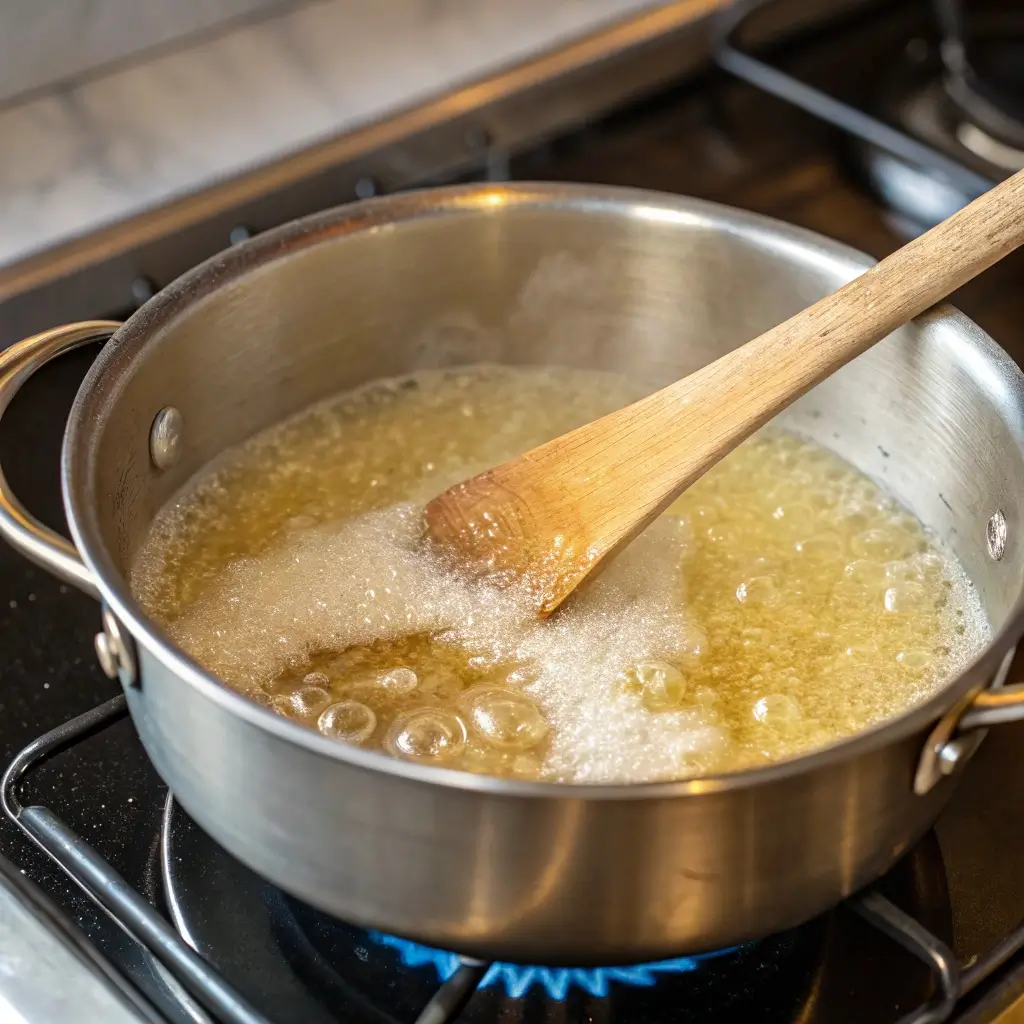
Step 4: Cook the Ginger in Syrup
- Add the drained ginger slices to the sugar syrup.
- Simmer over low heat for 15–20 minutes, stirring occasionally, until the ginger is translucent and most of the liquid has evaporated.
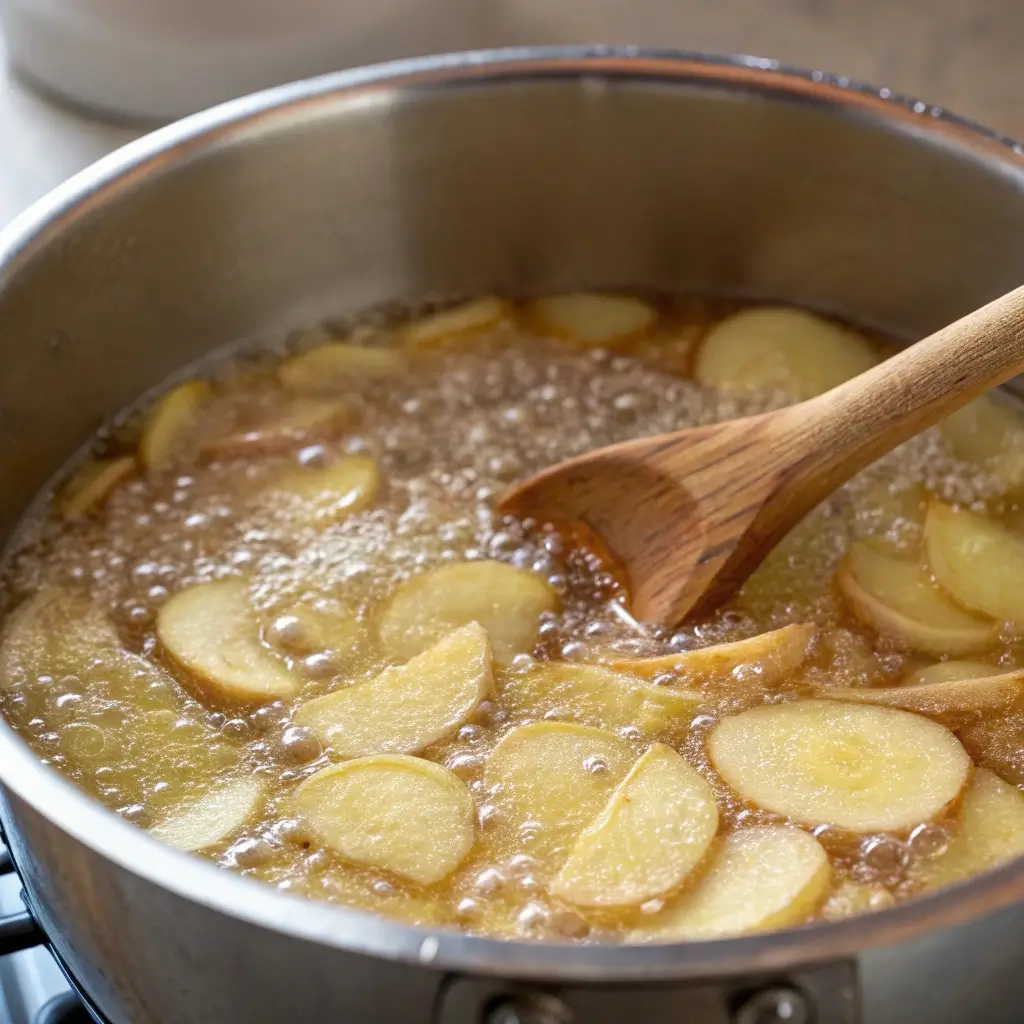
Step 5: Dry and Coat the Ginger
- Use a slotted spoon to transfer the ginger to a wire rack or parchment paper, spreading the pieces out.
- Let them dry for about 1–2 hours until they are slightly sticky but no longer wet.
- Toss the ginger in granulated sugar to coat each piece evenly.
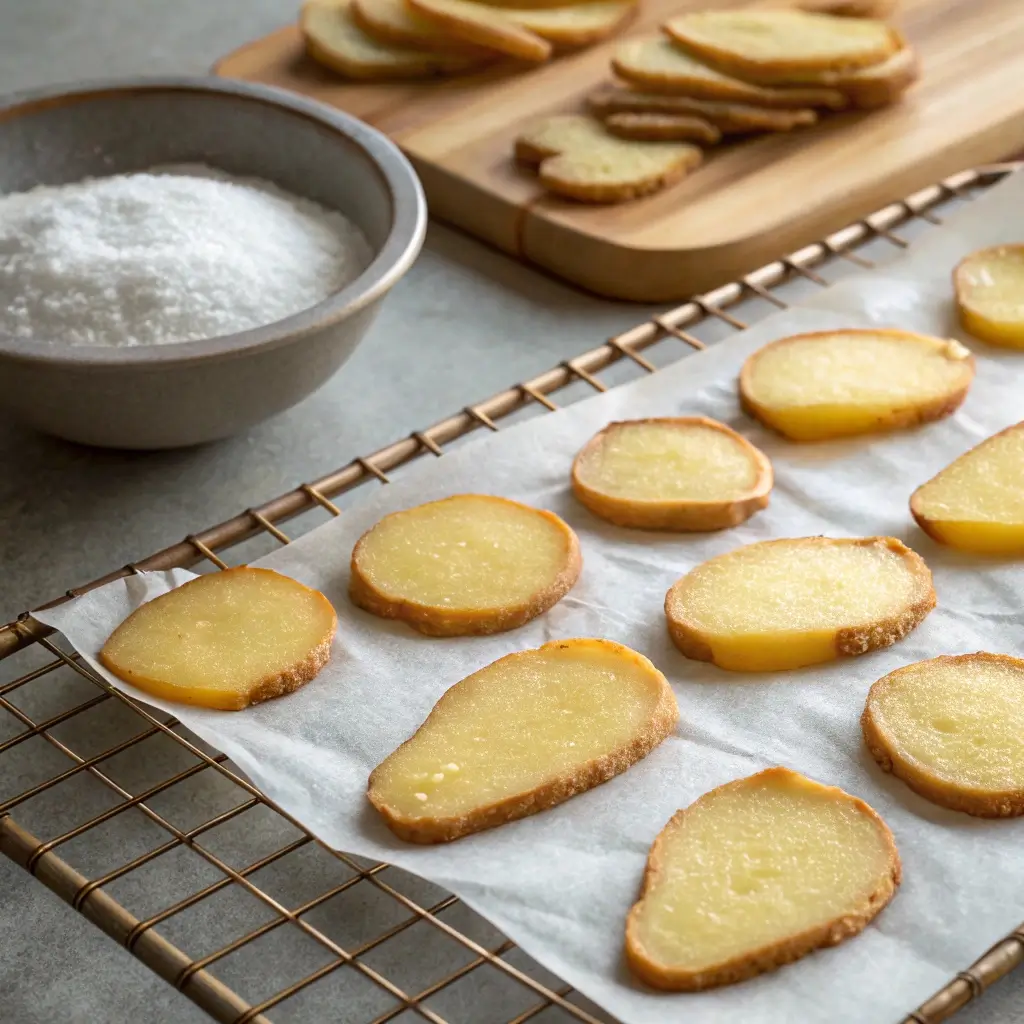
Step 6: Store and Enjoy
- Once completely dry, store the crystallized ginger in an airtight container at room temperature.
- It stays fresh for up to 3 months and can be used in baking, tea, or eaten as a snack!
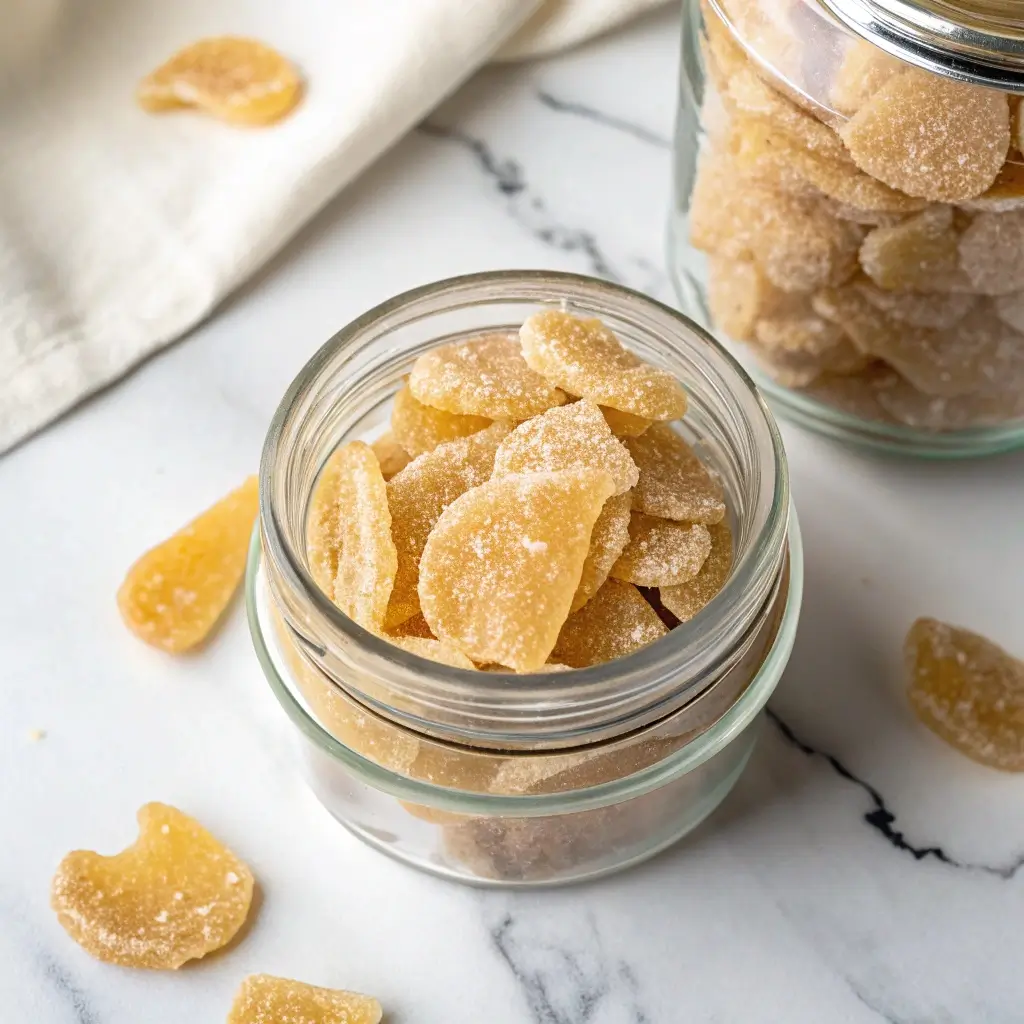
Tips for Perfect Crystallized Ginger
Making homemade crystallized ginger is simple, but these expert tips will help you achieve the best flavor, texture, and shelf life.
1. Choose the Right Ginger
- Use young, fresh ginger for a milder, less fibrous texture.
- Older ginger has a stronger spice level but can be tougher to chew.
2. Slice Evenly for Consistent Texture
- Cut ginger slices ⅛ to ¼ inch thick for even cooking.
- Thicker slices will be chewier, while thinner slices will dry faster.
3. Simmer Until Tender
- Boil the ginger until fork-tender before adding it to the sugar syrup.
- Undercooked ginger will be too firm and difficult to chew.
4. Use Reserved Cooking Water for Extra Flavor
- Adding ½ cup of the ginger cooking water to the sugar syrup enhances the ginger’s natural taste.
- This also prevents the ginger from losing its essential oils.
5. Let the Ginger Dry Properly
- Place the ginger pieces on a wire rack or parchment paper to dry evenly.
- Avoid stacking pieces on top of each other, as this can cause sticking.
Common Mistakes to Avoid When Making Crystallized Ginger
Even with a simple recipe, small mistakes can affect the taste, texture, and shelf life of crystallized ginger. Here are some common pitfalls and how to avoid them.
1. Using Old or Dried-Out Ginger
- Mistake: Choosing old, fibrous ginger results in tough, stringy pieces.
- Solution: Use fresh, young ginger, which is smoother and easier to chew.
2. Cutting Uneven Slices
- Mistake: Thick or uneven slices cook at different rates, leading to some pieces being too soft while others stay hard.
- Solution: Slice the ginger consistently (⅛ to ¼ inch thick) to ensure even cooking.
3. Skipping the Initial Boiling Step
- Mistake: Not boiling the ginger before adding it to the sugar syrup makes it too spicy and firm.
- Solution: Always boil the ginger first until tender before moving on to the sweetening step.
4. Not Letting the Ginger Dry Properly
- Mistake: Storing crystallized ginger while it’s still damp leads to stickiness and clumping.
- Solution: Let it dry completely before transferring it to an airtight container.
5. Using Too Much or Too Little Sugar
- Mistake: An incorrect sugar-to-ginger ratio affects both taste and texture.
- Solution: Use equal parts sugar and ginger for the best balance of sweetness and spice.
6. Storing It Incorrectly
- Mistake: Keeping ginger slices in an open container causes it to harden or become sticky.
- Solution: Store it in an airtight container in a cool, dry place for freshness.
By avoiding these mistakes, you’ll get perfectly chewy and flavorful crystallized ginger every time!
How to Store and Reheat Crystallized Ginger
Storing homemade ginger slices properly ensures they stay fresh, chewy, and flavorful for months. Follow these simple tips to keep them in the best condition.
How to Store Crystallized Ginger
Room Temperature (Best for Short-Term Use)
- Store in an airtight container in a cool, dry place.
- Keeps fresh for up to 3 months.
Refrigeration (For Humid Climates)
- Place in a sealed container to prevent moisture absorption.
- Lasts up to 6 months in the fridge.
Freezing (For Long-Term Storage)
- Store in a ziplock bag or freezer-safe container.
- Stays fresh for up to 1 year.
How to Reheat Crystallized Ginger
If your crystallized ginger becomes too hard, you can soften it using these methods:
Microwave Method (Quick Fix)
- Place a small amount on a microwave-safe plate.
- Heat for 5–10 seconds to soften slightly.
Steam Method (Restores Chewiness)
- Place the ginger in a heatproof bowl over a pot of steaming water.
- Cover and steam for 1–2 minutes until soft.
Sugar Syrup Method (For Sticky, Dried-Out Ginger)
- Heat a small amount of sugar syrup in a pan.
- Toss the ginger in the warm syrup for 30 seconds, then let it cool.
By storing it properly and reheating when needed, you can enjoy crystallized ginger anytime without losing its texture or flavor!
Variations of Crystallized Ginger Recipes
Crystallized ginger is delicious on its own, but you can customize the recipe to match different dietary needs and flavor preferences. Here are some creative variations to try:
1. Sugar-Free Crystallized Ginger (Keto & Diabetic-Friendly)
How to Make It:
- Replace granulated sugar with erythritol, monk fruit sweetener, or allulose.
- Follow the same steps, but use a sugar-free syrup instead of regular sugar syrup.
- Skip the final sugar coating or use a sugar substitute.
Why Try It?
- Perfect for low-carb or keto diets.
- Helps reduce blood sugar spikes while keeping the spicy-sweet flavor.
2. Spiced Crystallized Ginger (For Extra Warmth)
How to Make It:
- Add cinnamon, cloves, or nutmeg to the sugar syrup while simmering the ginger.
- For a spicier kick, include a pinch of cayenne pepper.
Why Try It?
- Enhances the warm, aromatic notes of ginger.
- Pairs well with holiday baking and herbal teas.
3. Honey-Crystallized Ginger (Natural Sweetener Option)
How to Make It:
- Replace half of the sugar with raw honey for a more natural sweetness.
- Stir honey into the syrup at the end of cooking to prevent burning.
Why Try It?
- Adds a softer, floral sweetness.
- A great option for those avoiding refined sugar.
4. Lemon-Infused Crystallized Ginger (Refreshing & Citrusy)
How to Make It:
- Add lemon juice and zest to the sugar syrup while cooking.
- Optional: Sprinkle finely grated lemon zest over the finished ginger.
Why Try It?
- Brightens the flavor with a tangy, citrusy twist.
- Perfect for adding to tea and desserts.
5. Extra Chewy Crystallized Ginger (Soft Texture Option)
How to Make It:
- Slice the ginger slightly thicker (¼ inch) before cooking.
- Reduce the final drying time to keep it extra chewy.
Why Try It?
- Great for snacking without a crunchy texture.
- Works well for mixing into cookies and granola bars.
Experimenting with these crystallized ginger variations lets you tailor the recipe to your taste and dietary needs.
FAQs About Crystallized Ginger
Here are answers to some of the most common questions about crystallized ginger, including its benefits, uses, and storage tips.
1. What is crystallized ginger good for?
Crystallized ginger is great for aiding digestion, soothing nausea, and adding flavor to recipes. It can be eaten as a snack, mixed into baked goods, or steeped in tea for a warm, spicy infusion.
2. Is candied ginger the same as crystallized ginger?
Not exactly. While both are made by cooking ginger in sugar syrup, candied ginger remains in syrup, making it soft and sticky, while crystallized ginger is dried and coated with sugar, giving it a firmer texture.
3. Can you just eat crystallized ginger?
Yes! Crystallized ginger is delicious on its own and makes a great natural snack. However, it has a strong, spicy-sweet flavor, so it’s best eaten in moderation.
4. How much crystallized ginger should you eat a day?
The ideal amount varies, but 1–2 small pieces per day is usually enough to enjoy the benefits without consuming too much sugar. If using it for nausea relief, start with a small amount and see how your body responds.
5. What is the best way to chop crystallized ginger?
For easy chopping:
Use a sharp knife to cut it into small pieces.
If it sticks to the blade, sprinkle a little flour or powdered sugar to reduce stickiness.
For finely chopped ginger, use a food processor in short pulses.
6. Is eating crystallized ginger healthy?
Crystallized ginger contains antioxidants and digestive benefits, but it is also high in sugar. Eating it in moderation can be part of a balanced diet, especially if paired with healthy snacks like nuts or dark chocolate.
Conclusion
Making homemade crystallized ginger is a simple yet rewarding process that allows you to enjoy this sweet and spicy treat in a variety of ways. Whether you’re using it for baking, snacking, or soothing digestion, this step-by-step guide ensures you get the perfect texture and flavor every time.
By following the right techniques, avoiding common mistakes, and experimenting with different variations, you can customize crystallized ginger to suit your taste and dietary needs. Plus, with proper storage, it stays fresh for months, ready to enhance your favorite recipes.
Now that you know how to make, store, and use crystallized ginger, it’s time to give it a try! Enjoy the warming, zesty kick of this homemade treat and get creative with your own variations.
You May Also Like :
The Best Natural Mounjaro Recipe for Balanced Nutrition
Himalayan Salt: Everything You Need to Know for Amazing Benefits
Peanut Butter Benefits – A Superfood for Health
Want to learn more about recipes, and wellness tips? Follow us on Facebook for daily updates! Visit our Facebook page here.

Homemade Crystallized Ginger
Ingredients
Method
- Peel the ginger using a spoon, vegetable peeler, or knife.
- Slice it into thin, even pieces (about ⅛ to ¼ inch thick) for uniform cooking.
- Place the sliced ginger in a saucepan and cover with water.
- Bring to a boil and simmer for 30–40 minutes, until the ginger becomes tender.
- Drain the ginger, reserving ½ cup of the cooking water for the syrup.
- In the same saucepan, combine 1 cup of sugar with the reserved ½ cup of cooking water.
- Stir over medium heat until the sugar dissolves and the mixture starts to bubble.
- Add the drained ginger slices to the sugar syrup.
- Simmer on low heat for 15–20 minutes, stirring occasionally, until the ginger is translucent and most of the liquid has evaporated.
- Use a slotted spoon to transfer the ginger to a wire rack or parchment paper, spreading the pieces out.
- Let them dry for 1–2 hours, until slightly sticky but no longer wet.
- Toss the ginger in ½ cup of granulated sugar to coat each piece evenly.
- Once completely dry, store the crystallized ginger in an airtight container at room temperature.
- It stays fresh for up to 3 months and can be used in baking, tea, or eaten as a snack!
Nutrition
Notes
- Sugar-Free Version: Use erythritol, monk fruit, or allulose instead of sugar.
- Extra Chewy Version: Slice ginger thicker (¼ inch) and reduce drying time.
- Lemon-Ginger Twist: Add lemon zest and juice to the syrup.


